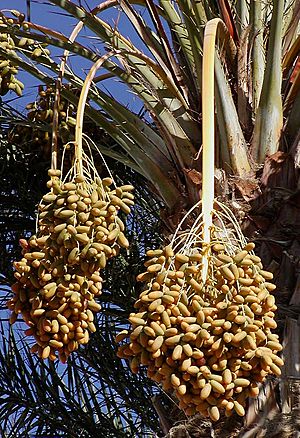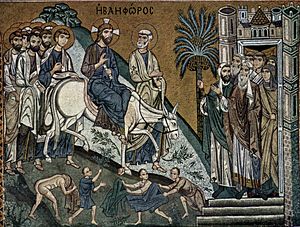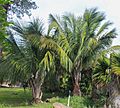Palm tree facts for kids
Quick facts for kids Arecaceae (palm family) |
|
|---|---|
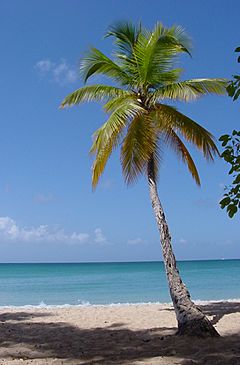 |
|
| The coconut palm, Cocos nucifera | |
| Scientific classification | |
| Kingdom: | |
| Division: | |
| Class: | |
| Order: |
Arecales
|
| Family: |
Arecaceae
|
Palm trees are a group of plants that can be trees, shrubs, or even climbing vines. They belong to a special plant family called Arecaceae. This family is the only one in a larger group called Arecales. Palms usually grow in warm places around the world.
Some well-known palm trees are:
There are about 2,600 different types, or species, of palm trees. Most of them live in tropical, subtropical, and warm temperate climates.
Palms are very famous and are planted widely. They have been important to people for a long time. Many everyday products and foods come from palms. You often see them in parks and gardens in areas where it does not get very cold.
In the past, palms were symbols of victory, peace, and good harvests. Today, palms are a popular symbol for warm, sunny places and vacations.
Contents
Where Do Palms Grow?
Most palm trees grow in the tropical and subtropical parts of the world. You can find them from about 44 degrees north to 44 degrees south of the equator. For example, the dwarf palm (Chamaerops humilis) grows in southern France. The Nikau (Rhopalostylis sapida) is a palm found in New Zealand. The toughest palm is the needle palm (Rhapidophyllum hystrix). It can survive in temperatures below -18°C (0°F)!
What Do Palms Look Like?
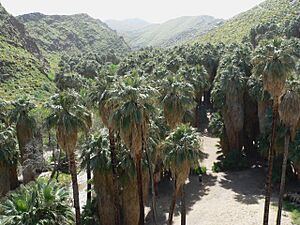
Most palms have a straight, single stem that does not branch. But some have branching stems, or they can even be creeping vines, like the rattan palm. They have large leaves that stay green all year. These leaves are either 'fan-shaped' (palmate) or 'feather-shaped' (pinnate). They grow in a spiral at the top of the trunk.
The base of each leaf forms a tube that usually splits open on one side. Palm flowers grow on a special branch called an inflorescence. This branch holds many tiny flowers. The flowers are usually small, white, and star-shaped. They typically have three sepals and three petals. The fruit usually has one seed surrounded by soft flesh. The well-known coconut is actually the seed of a very large fruit. Some palm fruits can have two or more seeds inside.
Where Palms Live
More than two-thirds of palm species live in tropical forests. Some grow very tall and become part of the forest's top layer, called the canopy. Other shorter palms grow underneath, forming part of the understory. Some types of palms grow closely together in areas that are often wet or flooded.
Other palms live on tropical mountains, even above 1,000 meters high. Palms can also be found in grasslands and scrublands, usually near water. They even grow in desert oases. A few palms are able to live in very basic lime soils. Others are good at living in very acidic soils.
Amazing Palm Trees
The Coco de mer palm has the biggest seeds of any plant. They are 30-50 centimeters (12-20 inches) wide and weigh 15-30 kilograms (33-66 pounds) each! Raffia palms have the largest leaves of any plant, up to 25 meters (82 feet) long and 3 meters (10 feet) wide.
The Corypha palms have the largest inflorescence (flowering part) of any plant. It can be up to 7.5 meters (25 feet) tall and hold millions of tiny flowers. The wax palm, which is Colombia's national tree, is the tallest palm in the world. It can reach heights of 70 meters (230 feet)!
Ancient Palms
Palms first appeared in the fossil record about 80 million years ago. This was during the late Cretaceous period, when dinosaurs were still around. Some types of palms from that time, like the nipa palm, are still alive today.
Palms in Danger
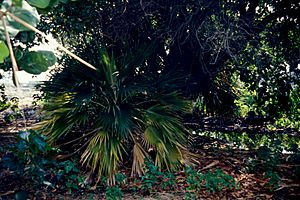
Like many other plants, some palm species are in danger of disappearing. This is mostly because of human activities. Growing cities, mining, and turning forests into farmland are big threats. Harvesting the "heart of palm" for food also harms palms. This part comes from the inner core of the tree, and taking it usually kills the tree.
The use of rattan palms for furniture has also caused their numbers to drop. This is because they are often collected from the wild instead of being grown on farms. Selling wild palm seeds to growers and collectors is another threat.
At least 100 kinds of palms are in danger. Nine types are believed to have already died out recently. It is hard to save palm seeds because they are often damaged by cooling. Cooling is the usual way to store rare seeds for the future. Also, planting rare palms in parks cannot truly replace their wild homes, and the plants might not grow well there.
The Palm Specialist Group of the World Conservation Union (IUCN) started in 1984. They worked with the WWF. This group collected a lot of information about palms from around the world. In 1996, they created a plan to help save rare palms.
Palm Pests
Some pests that attack palm trees include:
- Raoiella indica, also known as the red palm mite.
- Caryobruchus gleditsiae, which is called the palm seed beetle or palm seed weevil.
How People Use Palms
Date Palms in History
People have used palms for a very long time, even before modern civilization. For example, people in Mesopotamia and the Middle East started growing date palms over 5,000 years ago. The Date Palm was very important in the history of the Middle East. A historian named W.H. Barreveld wrote:
"If the date palm had not existed, people would not have been able to spread so much into the hot and dry parts of the 'old' world. The date palm gave them food with lots of energy that could be stored and carried on long trips across deserts. It also made a better place for people to live by giving shade and protection from desert winds. Plus, the date palm also provided many products for farming and for things used at home. Almost every part of the palm was useful."
The importance of palms in the Middle East long ago is also shown in religious texts. They are mentioned more than 30 times in the Bible and over 22 times in the Qur'an.
Food and Drinks from Palms
Besides the well-known coconut and date, other foods come from palms. Palm oil, sago, heart of palm, and palm wine are all eaten or drunk in different parts of the world. Palm oil is used in many products, from makeup to food ingredients.
Palms in War
South Carolina is called the Palmetto State. This nickname comes from the sabal palmetto tree. Logs from this tree were used to build the fort at Fort Moultrie. During the American Revolutionary War, the soft wood of these palms helped stop British cannonballs.
Other Uses of Palms
Coir is a rough, water-resistant fiber from the outer shell of coconuts. It is used to make doormats, brushes, mattresses, and ropes. 'Dragon's blood' is a resin that comes from the fruit of the rattan palm. It is used in dyes, varnishes, and incense. The Washingtonia robusta trees line Ocean Avenue in Santa Monica, California.
Today, palms are popular in parks and gardens in countries outside the tropics. Two types that can handle cold weather well are the Chusan palm from eastern Asia and the needle palm from the United States.
Palms as Symbols
The palm branch was a symbol of success and victory in Roman times. Romans would give palm branches to champions of games and celebrate war victories with them. Jews also had a tradition of carrying palm branches during festive times.
The motto of the University of Southern California is Palmam qui meruit ferat. In Latin, this means "Let him bear the palm who has deserved it." Palms appear on the flags and seals of several places where they grow naturally. These include Haiti, Guam, Florida, South Carolina, and Samoa.
In Religion
The palm has many meanings in both old and new religions from the Middle East.
Christianity
Early Christians used the palm branch to show the victory of good over evil. This is seen in the Palm Sunday festival, which celebrates Jesus's entry into Jerusalem. In Christian art, martyrs (people who died for their faith) were often shown holding palms. This symbolized their victory of spirit over their physical suffering. People widely believed that a picture of a palm on a tomb meant a martyr was buried there.
In Other Faiths
In Judaism, the palm represents peace and plenty. The palm can also symbolize the Tree of Life in Kabbalah. The Prophet Muhammad is said to have built his home from palm materials. The palm represents rest and welcome in many Middle Eastern cultures.
Palm stems represented long life to the Ancient Egyptians. The god Huh was often shown holding a palm stem in one or both hands. The sacred tree of the Assyrians was a palm. It represented the god Ishtar connecting heaven (the crown of the tree) and earth (the base of the trunk). The Mesopotamian goddess Inanna, who was part of a special marriage ritual, was thought to make dates grow in large numbers. The palm tree was a sacred sign of Apollo in Ancient Greece because he was born under one.
Modern Times
The palm, especially the Coconut, is still a symbol of a tropical island paradise. The palm tree also represents an Oasis in a desert.
Cultural Importance
Rabindranath Tagore wrote a long and famous poem about a special type of palm tree.
Images for kids
-
Sawn palm stem: Palms do not form annual tree rings.
-
Two Roystonea regia palms in Kolkata, India. You can see their special crownshaft and top shoot.
-
Silhouettes of palms in KwaZulu-Natal, South Africa.
-
Palmyra palm fruit at Guntur, India.
-
A man standing in front of palms in Los Angeles, California.
-
Edward Hitchcock's chart from his 1840 book, showing Palms as the top of the plant tree of life, just like humans are the top of the animal tree.
-
Washingtonia robusta palms line Ocean Avenue in Santa Monica, California.
-
A Sabal palm in the Canaveral National Seashore.
See also
 In Spanish: Palmeras para niños
In Spanish: Palmeras para niños


